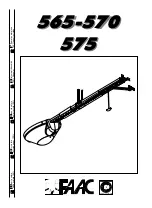
remember to use the STOP button to stop the door at the Fully
Open Position.
4) Depress the limit nut retaining plate (D) so it disengages
from the slots in the limit nuts. Turn the OPEN limit nut (E) on
the shaft until it engages the Open Limit Switch (A). You will
need to listen for an audible click. Release the retaining bracket
and be sure that it engages in slots of both limit nuts.
5) With all due care use the built-in three button station on
the motor control board or the wall mounted three button station
to lower the door to approximately 4 inches shy of the fully
closed position and repeat Step #4 with the Close Limit nut (C)
and the Close Limit switch (B). The actual Close Limit position
is a timed function whereas the door continues to run for a
certain period of time after the Close Limit switch is activated.
This amount of time (Close Limit Delay) is factory set to 0.32
seconds and will provide reversing cutout of approximately 4
inches from the floor for a door traveling at 12 inches per
seconds. If the door fails to reverse when an object at least four
inches high is placed in its path (see Testing, page 19) it may be
necessary to adjust the Close Limit Delay time, see procedure
on page 15.
6) Move the door to the fully open position then the fully
closed position and observe the stopping position. Reset the
Limit Nut(s) per above instructions if desired.
7) A fine adjustment can be done (if necessary) by loosening
the screws holding the Limit Switches to the V bracket and
moving the switch within the slots on the bracket.
TO AVOID RISK OF ENTRAPMENT AND
POSSIBLE DAMAGE TO THE DOOR AND
OPERATOR THE CLUTCH MUST BE
ADJUSTED AND ANY ENTRAPMENT
PRTOTECTION DEVICES CONNECTED
BEFORE APPLYING POWER TO THE
OPERATOR TO SET THE LIMITS.
WARNING
SETTING THE LIMIT SWITCHES
1) With the cover open on the electrical enclosure, reference
Figure 23 below. There are two (2) switches (A and B) mounted
to the ‘V’ bracket (F). The switches are activated by the two limit
nuts (C and E) on the threaded shaft which move laterally along
the shaft as the operator opens and closes the door. When a limit
nut nears the end of the shaft it activates a switch, that send a
message back to the motor control board to stop the door. Follow
either 2 or 2A below depending on how the door and trolley are
orientated.
2) For original installation setting, the door (connected as
normal to the operator trolley) should be positioned approximately
4 inches shy of the fully closed position. If this is the case, depress
the Limit Nut Retention Plate (D) so it disengages from the slots
in the limit nuts and move the Close Limit Nut (C) on the shaft
until it engages the Close limit
Limit Switch (B) (see Step 5 for an
explanation of the Close limit
function). You will need to listen
for an audible click. Move the
Open Limit Nut (E) to the center of
the threaded shaft. Release the
retaining bracket and be sure that it
engages in slots of both limit nuts.
2A) If the door and operator
trolley are at some other position
other than fully closed, depress the
Limit Nut Retention Plate (D) so it
disengages from the slots in the
limit nuts and move the
BOTH
the
Limit nuts to the center of the
threaded shaft. Release the
retaining bracket and be sure that it
engages in slots of both limit nuts.
3) With all due care use the
built-in three button station on the
motor control board or the wall
mounted three button station to
raise the door to the fully open
position. You will need to
A
113116
B
E
C
D
F
Figure 22
Limit Assembly
A - OPEN LIMIT SWITCH
B - CLOSE LIMIT SWITCH
C - CLOSE LIMIT NUT
D - LIMIT NUT RETAINING PLATE
E - OPEN LIMIT NUT
F - “V” BRACKET
OPERATION AND ADJUSTMENT INSTRUCTIONS
17








































